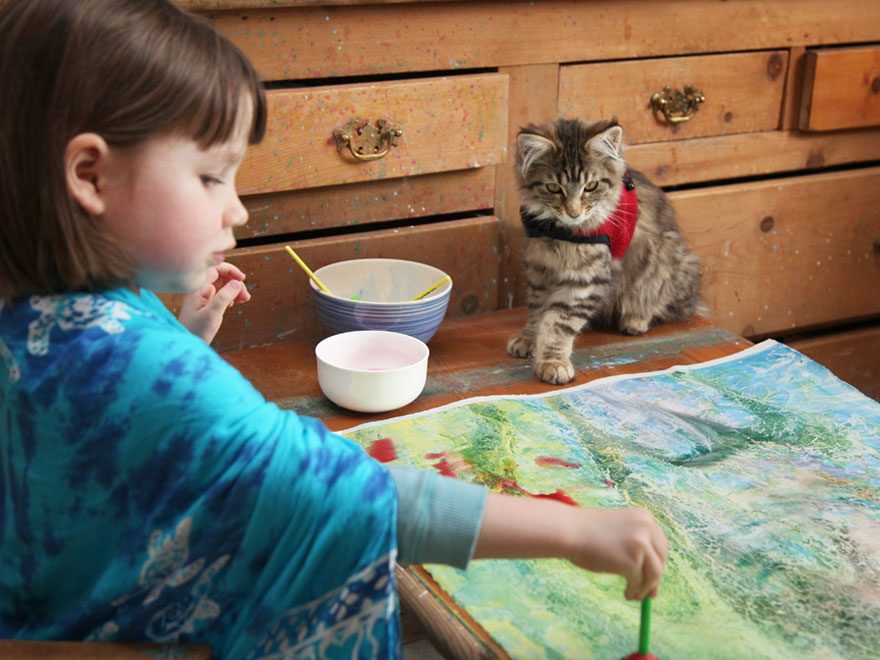Safety Rules for Kids Around Cats

For a family deciding to invest their love in a new pet, the typical debate usually falls on the two most common household pet staples: dog or cat. And the tiebreaker is typically a list of pros and cons, giving each possibility a fair assessment. For instance, felines are noticeably quieter in comparison to most dogs. Cats instinctually use a litter box, and unless trained, dogs do their business wherever they want.
For a quiet, well-managed home, where excess noise and simplicity are preferred, the cat is king. But felines have their issues, even at the kitten stages. Some of these include trimming their razor sharp claws, and if they’re a very young kitten without a mother for nursing, they require a feeding schedule. They will eventually become self-sufficient, but when they are little, they need lots of extra attention and support.
Kids and Cats
You want to keep your kids and your pet safe. There are a few things to consider:
- The cat’s breed: There are select breeds of feline that have the patience and flexibility to be perfect for children, especially children at a young age. The top five are American Curl, American Short Hair, Birman, Bombay, and Burmese. These are low-key, docile, yet still very playful breeds, that will benefit your children’s growing understanding of living things.
- The cat’s character: While some traits are specific to breeds and environmental factors, most cats have a character all their own. It has to do with their natural adaptation to their surroundings, to the people, and to how their natural inclinations work based on evolutionary programming.
- The cat’s level of trust: For cats to become familiar enough with your child to seek them out for attention, there must first be a bond of trust. They can also teach your children how to be respectful and patient, as well as other new concepts kids might not yet understand.
- The cat’s level of aggressiveness: Felines will lash out if provoked, but it can also be a response to an external factor that causes them fear or stress. They will also likely respond negatively to being hurt, for example, if a child pulls their tail. Sometimes, children do not realize that what they are doing is making a cat angry and wonder why their kitty scratched them when they were just giving them a snuggle. However, this can be prevented by showing kids how to handle a kitty. Most of the time, they squeeze just a little too hard. Teaching them the warning signs that their kitty is becoming unhappy can also help prevent scratching or biting.
- How playful the cat is: Most felines love to play, and that works for a family with active children who also love to play! They will hide, then spring out at the last second to scare you, and display many other energetic, creative behaviors. However, it can be startling to a kid toddling around in an infant walker, and the cat may not understand the difference in a positive and negative reaction. You must be ready for this possibility. Some kids might find it hilarious and joyful laughter will fill the home, but others might not enjoy the surprises a kitty might offer.
- Ease of adoption: Shelters are overrun with cats on a regular basis. This provides an opportunity to expose your kids to many different types of cats by fostering them while an agency sets up permanent placement. This will allow them to be introduced to a rotating list of different breeds and personalities. Sure, the trust must be earned again and again, but it will give your kids a wide range of cat friends to engage with. The shelter will be able to provide guidance about which kitties are best for children.
The bond between child and pet is a friendship that can last a lifetime, and just like any friendship, it needs a firm foundation of love and respect. Education is important if you want your kid’s bond with their cat to thrive, and the benefits are just as important for your kids as for your new furry family member. If you’re willing to put in the time and dedication, taking care of a cat is very rewarding!
Did these facts about cats and kids help you decide to introduce a cat in your children’s lives? Let us know in the comments below!






![Dj Scratch mixing some beats. 🎧 🎶 #Mewsic #KitNipBox
[via Instagram | @dharmacatnitiative]](https://www.kitnipbox.com/meow/wp-content/plugins/instagram-feed/img/placeholder.png)